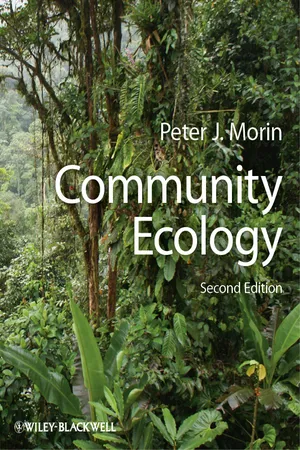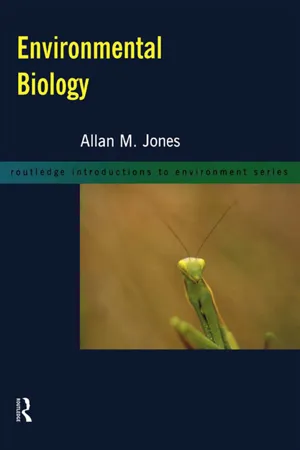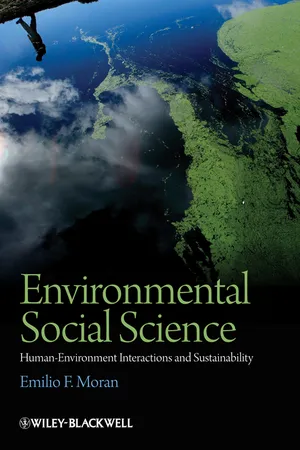Biological Sciences
Communities
Communities in biological sciences refer to groups of interacting species living in the same area. These interactions can include competition, predation, and mutualism, and they play a crucial role in shaping the structure and function of ecosystems. Understanding the dynamics of communities is essential for studying biodiversity, ecological processes, and conservation efforts.
Written by Perlego with AI-assistance
Related key terms
6 Key excerpts on "Communities"
- eBook - ePub
- Peter J. Morin(Author)
- 2011(Publication Date)
- Wiley-Blackwell(Publisher)
doesn’t stress interactions, but does emphasize that Communities are often identified by prominent features of the biota (dominant species) or physical habitat. Other succinct definitions include those by Peter Price (1984)“… the organisms that interact in a given area.” and by John Emlen (1977) “A biological community is a collection of organisms in their environment.”that emphasize the somewhat arbitrary nature of Communities as sets of organisms found in a particular place. Charles Elton’s (1927) definition, while focused on animals, differs from the previous ones in drawing an analogy between the roles that various individuals play in human Communities and the functional roles of organisms in ecological Communities.“One of the first things with which an ecologist has to deal is the fact that each different kind of habitat contains a characteristic set of animals. We call these animal associations, or better, animal Communities, for we shall see later on that they are not mere assemblages of species living together, but form closely-knit Communities or societies comparable to our own.”(Elton, 1927).Elton’s emphasis on the functional roles of species remains crucial to our understanding of how functions and processes within Communities change in response to natural or anthropogenic changes in community composition.For our purposes, community ecology will include the study of patterns and processes involving at least two species at a particular location. This broad definition embraces topics such as predator-–prey interactions and interspecific competition that are traditionally considered part of population ecology . Population ecology focuses primarily on patterns and processes involving single-species groups of individuals. Of course, any separation of the ecology of populations and Communities must be highly artificial, since natural populations always occur in association with other species in Communities of varying complexity, and since populations often interact with many other species as competitors, consumers, prey, or mutually beneficial associates.Most Communities are extraordinarily complex. That complexity makes it difficult even to assemble a complete species list for a particular locale (e.g., Elton 1966; Martinez 1991). The problem is compounded by the fact that the taxonomy of smaller organisms, especially bacteria, protists, and many invertebrates, remains poorly known (Wilson 1992; Foissner 1999; Hughes et al . 2001). Consequently, community ecologists often focus their attention on conspicuous readily-identified sets of species that are ecologically or taxonomically similar. One important subset of the community is the guild , a collection of species that use similar resources in similar ways (Root 1967; Fauth et al . 1996). There are no taxonomic restrictions on guild membership, which depends only the similarity of resource use. For example, the granivore guild in deserts of the southwestern USA consists of a taxonomically disparate group of birds, rodents, and insects that all consume seeds as their primary source of food (Brown and Davidson 1977). Another term, taxocene - eBook - ePub
- Allan M. Jones(Author)
- 2006(Publication Date)
- Routledge(Publisher)
Communities and ecosystems Key concepts A community is a dynamic and interactive collection of populations. An ecosystem comprises the biological community together with its physical environment. Communities are defined either by the habitat or by the dominant life-forms and occupy a variety of scales. Almost all populations and Communities are distributed patchily. Community interactions are founded upon trophic relationships and/or predator–prey relationships. Primary and secondary productivity varies markedly between ecosystems. Changes in composition and form of community vegetation follow distinct patterns known as ecological successions, usually ending with a relatively stable climax community. Biodiversity includes habitat, species and genetic components and is under threat from human activities. Stability of Communities and ecosystems is a function of three properties: persistence, constancy and resilience. Biogeographic distributions are the result of both historical (evolutionary) and ecological factors. The previous chapter shows how interactions at population level influence population dynamics, with population characteristics being shaped by environmental pressures, both biotic and abiotic. An ecological community is a dynamic collection of species populations occurring together in space and time within some common, defined habitat or environment; they are integrated or interact so as to influence other component members. The concept originated from the study of plant aggregations (phytosociology) but now applies to all organisms. Most Communities include mixtures of members from most kingdoms. Groups of populations forming a community are linked together by a complex range of interactions, directly or indirectly linking all its members together in a web. This web is very much based upon competitive and predator–prey relationships but many of the linkages are very subtle or ephemeral - eBook - ePub
- Irby J. Lovette, John W. Fitzpatrick(Authors)
- 2016(Publication Date)
- Wiley-Blackwell(Publisher)
1998). Note that this definition does not include any particular taxonomic limits, and birds are just one component of any group of potentially interacting organisms. However, some biologists argue that the groups we term Communities are artificial human constructs (Box 14.01). The term community includes only a subset of the organisms that influence the lives of birds, so the term species assemblage is often preferred when referring to only the avian component of a community. Moreover, biological Communities are often discussed without the numerous non‐biological factors that affect populations, such as climate and other environmental variables. An ecosystem is perhaps a more familiar and inclusive term that describes both the collection of species and physical environment in which they interact. Community: the set of ecologically interacting organisms of different species that occurs in the same location. Species assemblage: similar to “community,” the group of species found in a particular location or habitat. Ecosystem: the complete set of organisms—the biological community—along with the physical environment in a particular location or region. Box 14.01 Defining Communities The scientific view of Communities has evolved during the past century, from the proposals of the early and influential plant ecologist Frederick Clements—who viewed Communities as discrete entities (super‐organisms) comprised of co‐adapted species—to a view championed by a later ecologist, Henry Gleason. Gleason proposed that plant species are individualistically distributed along environmental gradients and sometimes form more discrete units of co‐occurring species, particularly where there is a sharp environmental gradient (such as a change in soil type). More recently, research on how species assemblages vary across space and time has tended to reinforce the idea that most so‐called “Communities” are not cohesive or co‐adapted units - eBook - ePub
- Laurie Ann Callihan(Author)
- 2013(Publication Date)
- Research & Education Association(Publisher)
CHAPTER 7 Population Biology CHAPTER 7 POPULATION BIOLOGY ECOLOGYEcology is the study of how organisms interact with other organisms and how they influence or are influenced by their physical environment . The word “ecology” is derived from the Greek term oikos (meaning “home” or “place to live”) and ology (meaning “the study of ”), so ecology is a study of organisms in their home. This study has revealed a number of patterns and principles that help us understand how organisms relate to their environment. First, however, it is important to grasp some basic vocabulary used in ecology.The study of ecology centers on the ecosystem. An ecosystem is a group of populations found within a given locality, including the abiotic environment around those populations. A population is the total number of a single species of organism found in a given ecosystem. Typically, there are many populations of different species within a particular ecosystem. The term organism refers to an individual of a particular species. Each species is a distinct group of individuals that are able to interbreed (mate), producing viable offspring. Although species are defined by their ability to reproduce, they are usually described by their morphology (their anatomical features).Populations that interact with each other in a particular ecosystem are collectively termed a community . For instance, a temperate forest community includes pine trees, oaks, shrubs, lichen, mosses, ferns, squirrels, deer, insects, owls, bacteria, fungi, etc.The part of the Earth that includes all living things is called the biosphere . The biosphere also includes the atmosphere (air), the lithosphere (ground), and the hydrosphere (water).A habitat refers to the physical place where a species lives. A species’ habitat must include all the factors that will support its life and reproduction. These factors may be biotic (i.e., living—food source, predators, etc.) and abiotic - eBook - ePub
- Mark Vellend(Author)
- 2016(Publication Date)
- Princeton University Press(Publisher)
PART II THE THEORY OF ECOLOGICAL CommunitiesPassage contains an image CHAPTER 4 The Pursuit of Generality in Ecology and Evolutionary Biology
The theory of ecological Communities is essentially my attempt at identifying and articulating the most general theoretical principles that cut across the plethora of ideas, concepts, hypotheses, and models in community ecology. Before I describe the theory in detail (Chap. 5 ), it is thus useful to consider other ways in which community ecologists have sought generality, why the results have been less than perfectly satisfactory, and why the body of theory from which I have taken inspiration—population genetics—is so widely accepted as providing a general and robust theoretical foundation for evolutionary biology. These are the goals I pursue in the present chapter, in addition to providing a brief summary of the theory of ecological Communities.4.1. GENERAL (AND NOT-SO GENERAL) PATTERNS IN ECOLOGICAL CommunitiesA dominant theme in ecology for many decades has been the search for patterns in nature that are “general,” meaning those that appear in a similar form under many different circumstances (e.g., not just in coral reefs, in arctic tundra, or in tropical forests, but in all three). MacArthur (1972) famously said that “to do science is to search for repeated patterns, not simply to accumulate facts.” We can think of this as a “pattern-first” approach to seeking generality in the science of ecology (Cooper 2003, Roughgarden 2009, Vellend 2010), and indeed, many repeated patterns can be found in nature. For example, the number of species almost always increases as a function of area, and such species-area relationships take a restricted range of forms (Rosenzweig 1995); Communities typically contain a few abundant species and many rare ones (McGill et al. 2007); and for many different groups of organisms, species diversity is greatest in the tropics and declines steadily toward the poles (Rosenzweig 1995). However, as far as I know, literally none of the “general” patterns in community ecology are universal (e.g., see Wardle et al. (1997) for a negative species-area relationship). Some relationships initially considered to be highly general have subsequently been found to vary greatly among systems (e.g., the diversity-productivity relationship; Waide et al. 1999). And most important, while one motivation for the pattern-first approach is the idea that a general pattern suggests a generally applicable cause or process (Brown 1995), many patterns can, in fact, be generated by several different causal pathways, often referred to as the “many-to-one” problem (Levins and Lewontin 1980). Consequently, the identification of frequently observed patterns in nature has not resulted in a general theory of ecological Communities. - eBook - ePub
Environmental Social Science
Human - Environment interactions and Sustainability
- Emilio F. Moran(Author)
- 2011(Publication Date)
- Wiley-Blackwell(Publisher)
3Theories and Concepts from the Biological Sciences1When biologists think about individual and species responses to global environmental change they have several guiding theories that are fundamental and which underlie their views – theories social scientists need at least a basic understanding of to effectively work with biologists. That is one of the goals of this chapter. Obviously, it is impossible in a brief chapter to cover all the relevant theories from the biological sciences, and thus I trust readers from the natural sciences will be forgiving if some important theories and concepts are omitted here. The goal is to introduce social scientists to those guiding theories that seem most relevant to current issues of cross-disciplinary human–environment interaction research, particularly to work on global environmental change.Biological ecology, rather than human ecology, is very much the focus here. It is rooted at one end on population genetics and the process of natural selection, and it extends all the way at the other end to studies of the structure of whole ecosystems (Richerson 1977). A chain of theory links natural selection at the individual level to the behavior of populations, and deduces testable theories of ecosystemic and community properties from the interaction of populations (ibid.). Among these fundamental theories and concepts are: (1) evolution by natural selection; (2) that species respond individualistically, not as Communities; (3) that interactions with other species help determine if a particular species will persist in a particular place; (4) whether top-down vs. bottom-up control of the community is operative in a given situation; (5) the role of succession in creating plant associations; (6) the implications of island biogeography to understand fragmentation and change; (7) the importance of biodiversity and ecosystem processes/ services; and (8) ecosystem structure and function.
Learn about this page
Index pages curate the most relevant extracts from our library of academic textbooks. They’ve been created using an in-house natural language model (NLM), each adding context and meaning to key research topics.





